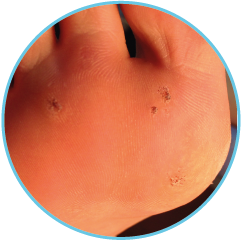Thorough assessment and clinical examination and clear diagnosis are imperative in treating Verrucae. At Stockport chiropody Clinic there are 3 main types of treatments available for treating Verrucae. Once clear diagnosis of Verruca Pedis has been clinically confirmed your chiropodist will advise you on the best course of treatment on a personal basis. This clinical decision will be based on various multiple factors, for example history of the Verruca (how long have you had it) medical history, previous treatments tried, pain levels or is the Verruca causing significant discomfort and so on. Verrucae can vary in size and can be found anywhere on the plantar area of the foot (underneath), the level of pain can also depend on size and whether it lies over a pressure point. Verrucae are caused by a virus, meaning it is very hard to eliminate, the patients own immune system need to act to resolve problematic verrucae, this can take weeks months or often many years. Therefore all treatments are based around the concept of stimulating a immune response within the patient to get rid and fight the problem.
Treatments Available
1. Routine Treatment and Clinical debridement of the Verruca
Sometimes the best course of treatment may be to continue with routine chiropody treatment. For example many patients will actually have a Verruca (or multiple) and not be aware of its presence, and therefore thorough routine treatment will probably be the preferable choice. If a patient attends the clinic with what they suspect is a Verruca which is causing significant pain and their feet are generally very good (i.e not needing any chiropody treatment) and they do not wish to have Cryotherapy then a very good course of treatment is simple scalpel debridement of the affected area of the foot where the Verruca is. This involves physically cutting off or gentle parring of the affected area with a sterile medical scalpel, the chiropodist will aim to remove as much skin/tissue as physically possible. The aim of this is to reduce pain and pressure by getting rid of the painful extra callus/hard skin that is associated with a Verruca. Sometimes a simple dry dressing may be required if the Verruca is vascular (bleeding). If this is the required treatment the chiropodist will advise you accordingly on when you should book another appointment. Clinical reduction of verrucae is found to be one of the best and least painful methods of stimulating a immune response.
2. Routine Treatment Clinical debridement and application of Silver Nitrate.
As above scalpel debridement will be carried out to reduce the pain, pressure and discomfort of the verrucae, and in doing so this will stimulate an immune response within the patient. Following this Silver Nitrate can be applied directly onto the affected sight/verrucae. Silver Nitrate is an older but effective method used to treat verrucae and warts. It is a mild corrosive that kills skin cells and is useful for treating some types of skin growths. This treatment will be applied carefully by the chiropodist in the form of a Silver Nitrate stick. The stick is moistened then applied directly onto the verrucae, some mild discomfort may be felt. But as with all verrucae treatments some discomfort or mild irritation is necessary for creating an effective immune response, so the bodies own natural immunity will take hold and destroy the verrucae. Silver Nitrate usually stains the affected area giving a black/brown appearance, this disappears after a few weeks. Up to six applications can be used on a verrucae, if the treatment is ineffective it will be stopped.
3. Cryotherapy
Cryotherapy involves the application of Liquid Nitrogen directly onto a Verruca for 15-30 seconds. The idea again is to create an immune response so the body will recognise and naturally destroy the Verrucae. Liquid Nitrogen is highly effective as it freezes the affected skin cells (causing them to burst), thus destroying them. Often a sore blister will form or a scab, this is part of the usual healing process. Essentially having cryotherapy is having controlled clinical frost bite. Multiple treatments are usually required. However if no improvement is seen after 5-6 treatments it is advised to cease treatment. A session of cryotherapy will take up to 30 minutes. It is advised to wait for at least 3-4 weeks before each treatment, and the affected area will be assessed on each appointment.
There are two different cryotherapy methods. Liquid nitrogen may be sprayed directly onto the wart, or it may be applied using a stick with cotton wool on the tip.
Cryotherapy is not usually recommended for everybody because some may find the treatment too painful. However sometimes the more painful a treatment is the stronger the immune response and therefore can be more effective.
Possible side effects of cryotherapy include:
- pain and blistering
- your skin may become darker (hyperpigmentation) or lighter (hypopigmentation) – particularly if you have black skin
- your nails may develop an abnormal change in shape or structure if cryotherapy is used to treat warts that develop around the nails (periungual warts)
- A very cold spray (dimethyl ether propane) is also available from pharmacies, which you can apply yourself. You should avoid using this spray on your face.
- Evidence suggests these sprays are not as effective as cryotherapy using liquid nitrogen.
Cryotherapy is at present not available at Stockport Chiropody Clinic. But we are aiming to introduce the treatment in early 2016.
From £25
Please contact the clinic for further details.

